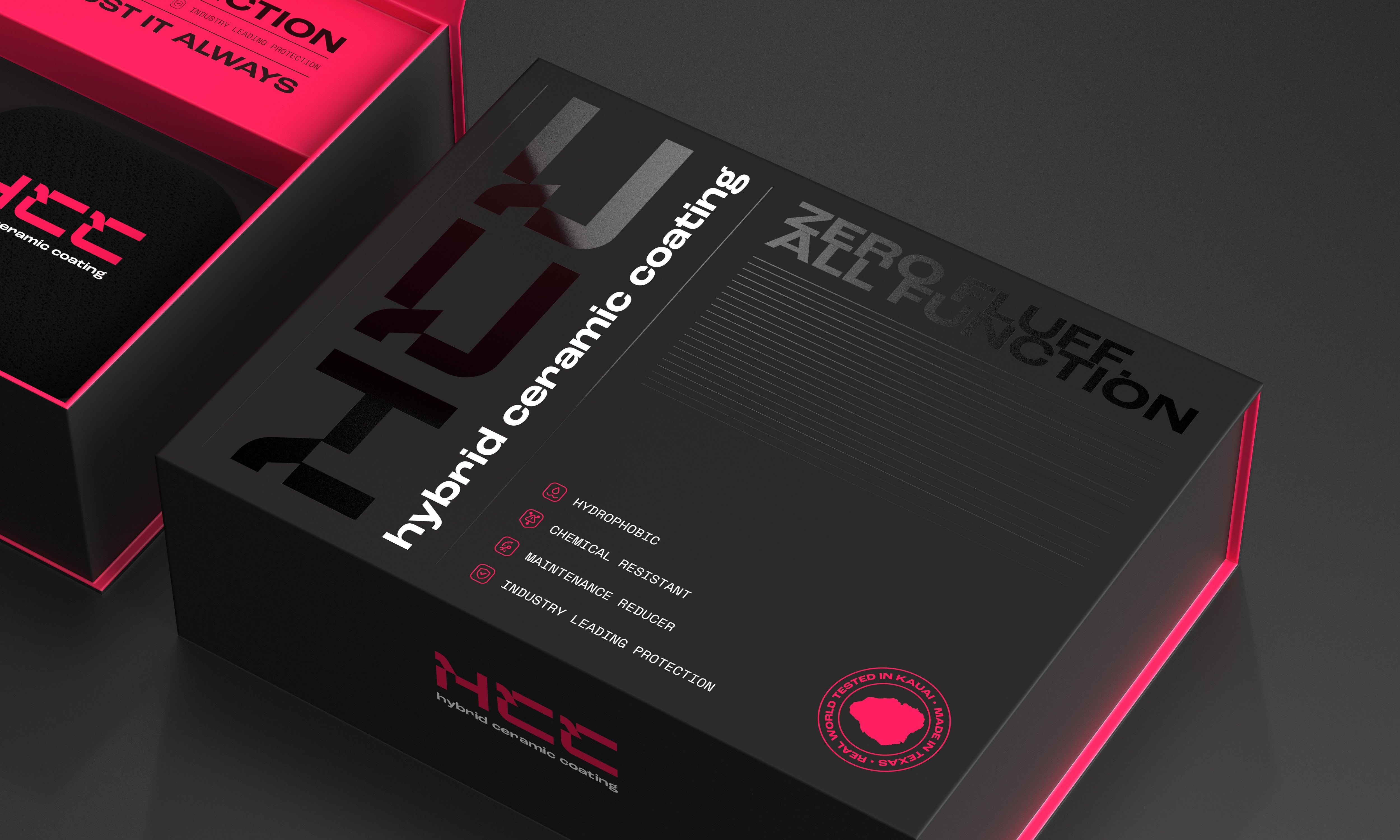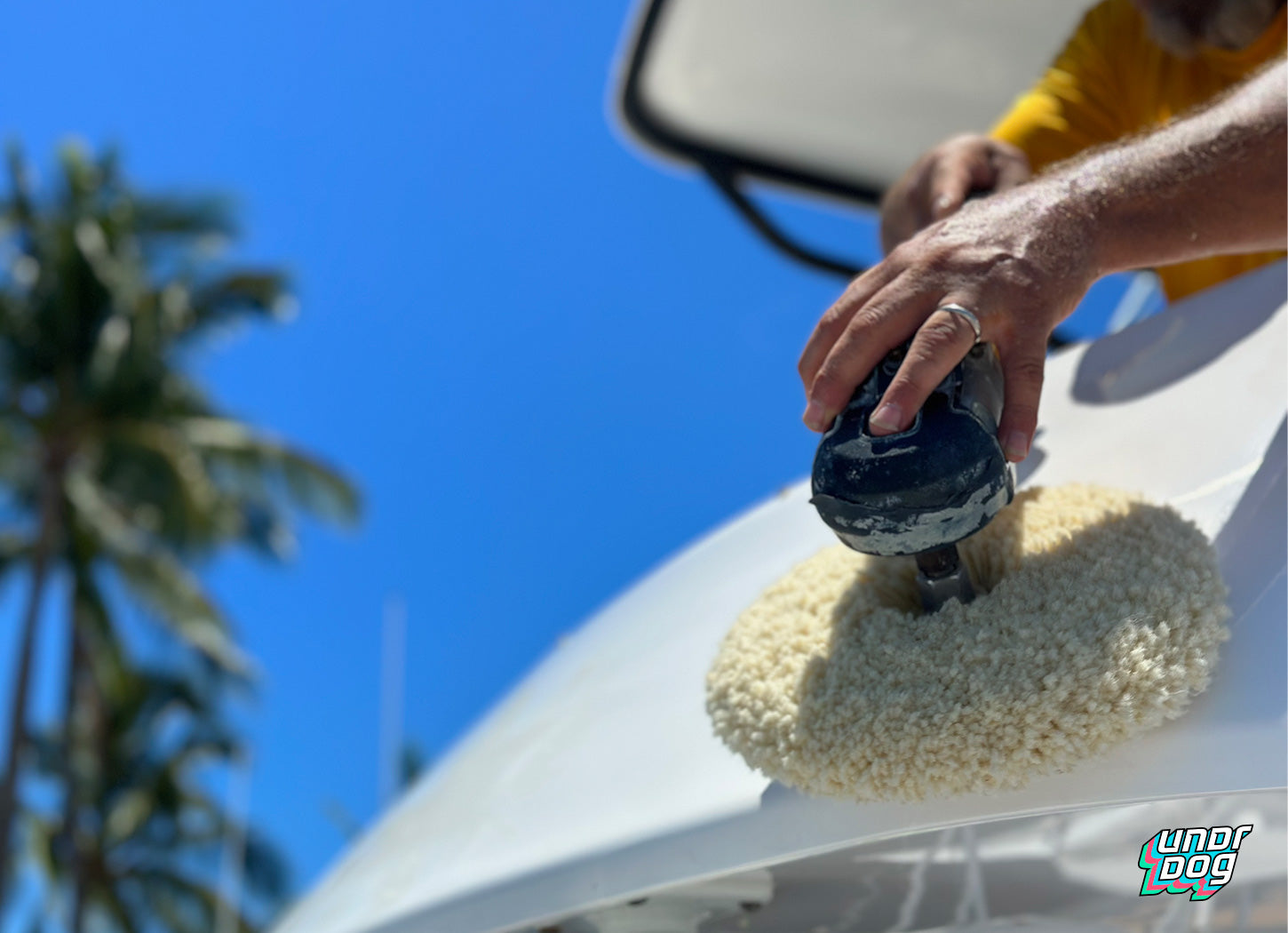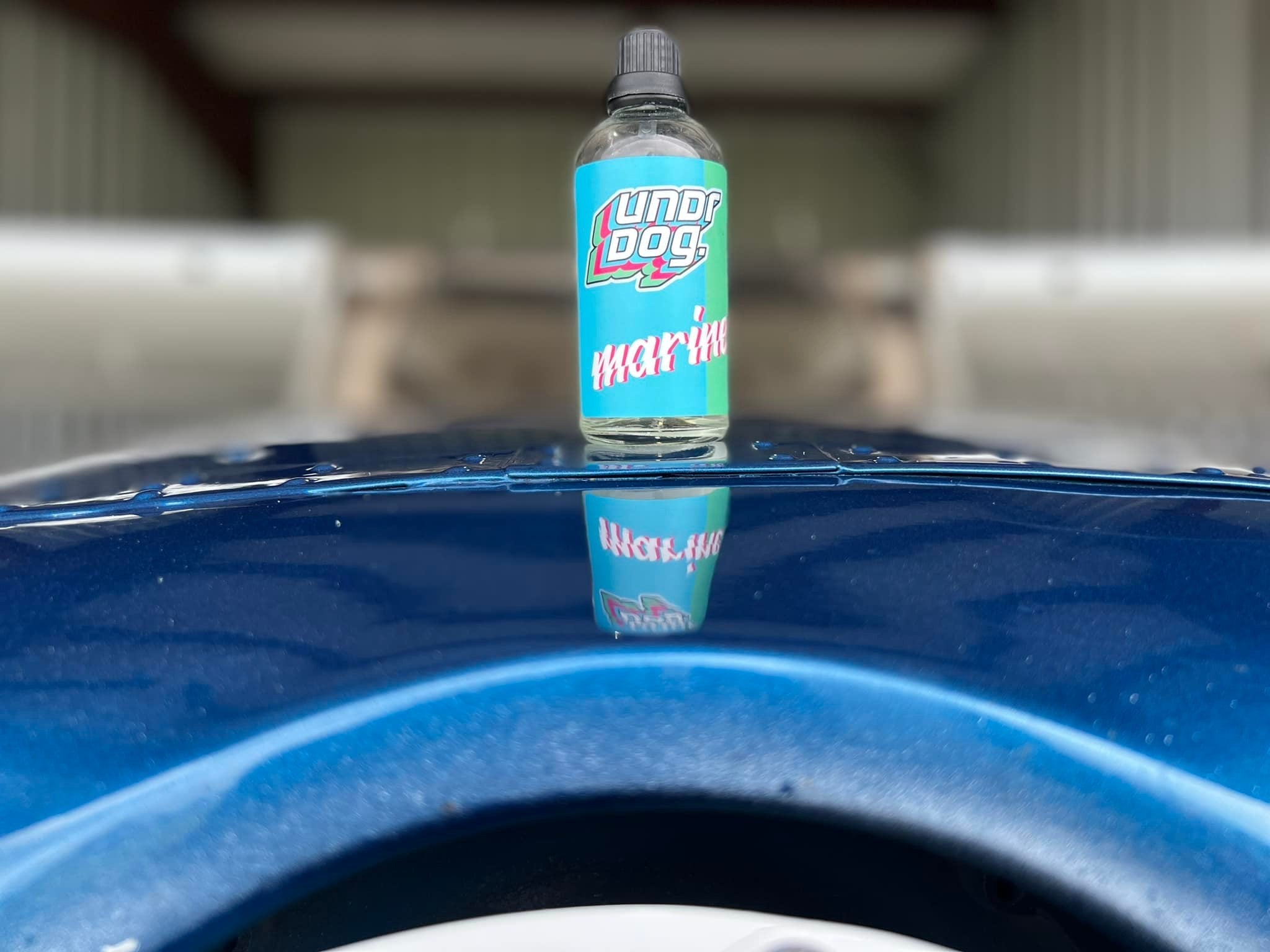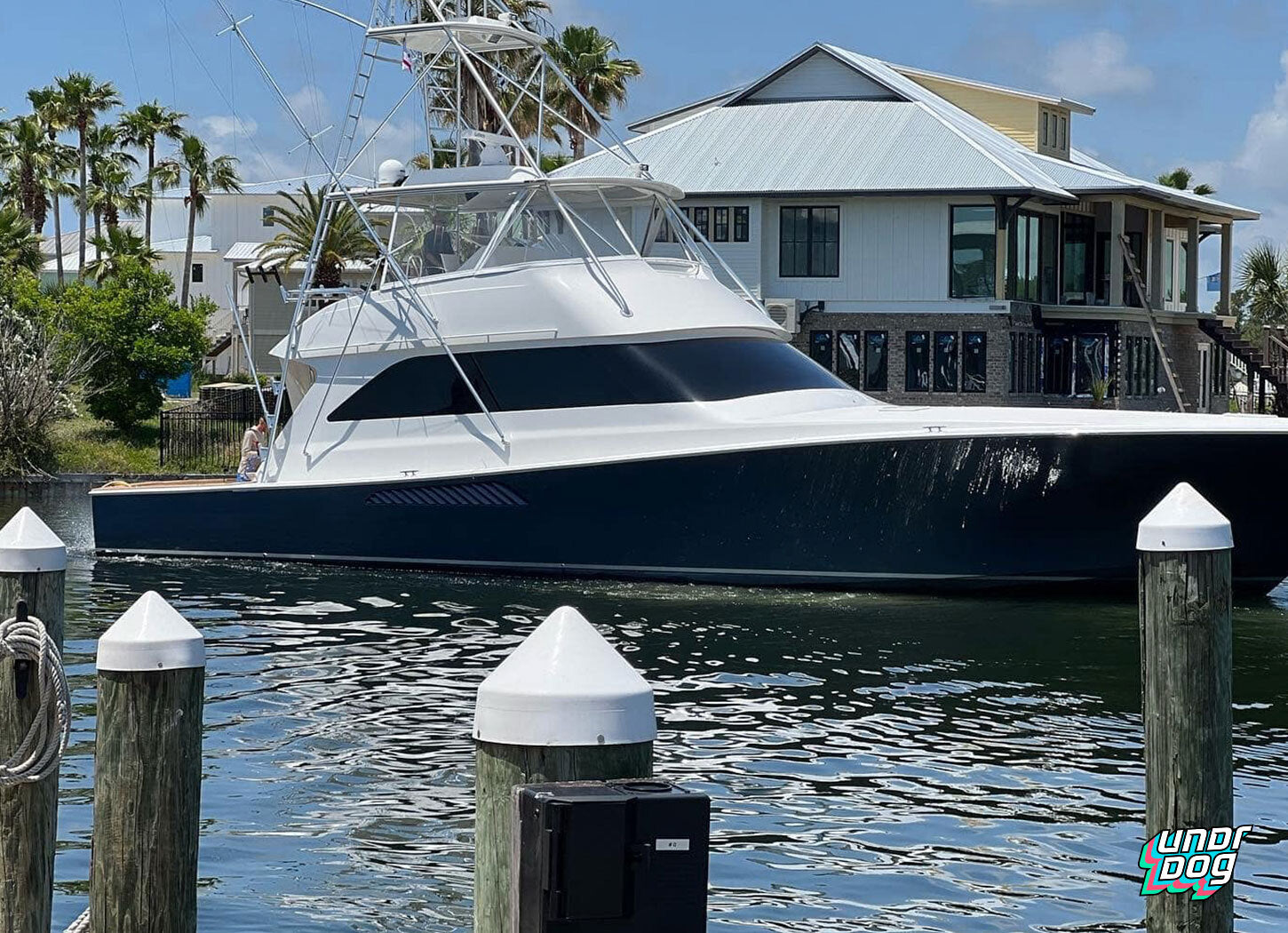TOC:
Ahoy sailor! In the last article, we covered the nitty gritty of boat detailing, which was just the first stage of our boat maintenance journey.
If you want to keep your vessel in top shape, you need to know how to polish a boat and take that hull from dull to dazzling.
In this guide, we'll walk you through the process of boat polishing, from understanding the importance of boat shine to mastering the techniques that will make your boat sparkle.
So get your boat pads and buffing compounds ready because we're about to make some waves. Hop aboard, and let's get started!

Why should you polish your boat?
I washed and cleaned my boat… Do I really need to polish it as well?
Well, if you’re ok with UV radiation and oxidation damaging your gel coat, you don’t have to do a thing.
If you’re not ok with your gel coat ending up damaged, then yes – you will need to polish your boat.
You see, making your boat shine goes beyond cosmetic enhancements. A well-polished boat looks stunning AND lives longer.
By removing oxidation, scratches, and stains, boat polishing helps maintain the integrity of your boat's gel coat, preserving its longevity and value.
So, as always, it’s not just about aesthetics and cosmetics. It’s about your baby’s hygiene and health.
Tools You Need To Polish Them Boats
Here's a rundown of the must-have items for your boat polishing kit:
| Tool | Purpose |
| Boat pads | Double-sided or single-sided wool pads are our personal favorite. But you can also use a heavy-cut foam pad or bigfoot polishers. |
|
Dual-action polisher |
A quality dual-action polisher will be your best friend throughout the boat polishing process. It provides the necessary power and control to buff and polish your boat's surfaces effectively. |
| Boat polish and boat compound | Choose marine-specific boat polish and compounds that are formulated to remove oxidation, scratches, and imperfections from your boat's surfaces. Look for high-quality products that provide long-lasting protection and shine. Our best boat polish of choice is Koch Chemie. |
| Marine soap | Specifically formulated for boat cleaning. It’s gentle on your boat but tough on grime. And yeah, it’s got to be a marine detailing soap. No other soap will do. Don’t even think about using car soap or house cleaning products. |
| Spray bottle | And some water in it. |
|
Microfiber towels |
These soft and lint-free towels are perfect for wiping off excess polish, buffing the surfaces, and achieving a flawless finish. |
| Safety stuff | Gloves, goggles… suit of armor? |
What you’re up against when polishing your boat
Your boat’s worst enemies are UV rays and oxidation which work together to cause damage to all kinds of surfaces. Whether it’s plastic, vinyl, paint, or gel coat, UV radiation and oxidation are the worst.
The Sun’s UV rays penetrate the gel coat and cause the pores to swell and increase in size. When the pores of the gel coat swell open, UV rays’ evil twin brother, Oxidation, steps in to wear down your hull.
The bigger the surface of your swollen gel coat, the more oxygen gets in touch with it. That’s how your surfaces become unsightly and start to degrade.
Here’s how you’ll know that your boat’s surface is under attack by UV rays and oxidation:
You will notice chalkiness and a light amount of cloudiness on the surface, especially when it reflects the light.
In more severe cases, your boat will completely lose its shine.
In the most severe cases, you’ll get a thin film all over your hand if you wipe your boat with it. That’s how you’ll know that your boat’s surface is alarmingly oxidized.
Oxidation looks unsightly, but that’s not the worst part of it. It’s like cancer that degrades the gel coat that protects the fiberglass and other parts of your boat.
If it penetrates the gelcoat, it becomes much more difficult to clean and can require a serious amount of mechanical abrasion to remove it.
Now, as you know, mechanical abrasion no es bueno.
So the best way to get rid of it is to prevent it from piling up. But if it already did pile up, you’re just gonna have to get rid of it. Here’s how…
How to polish yer boat like a champ
There are three paths you can go by.
Going from the least abrasive to the most abrasive method of polishing, we have:
- Wet sanding (the most aggressive and does the most amount of damage to your boat’s surface)
- Compounding (middle child - moderate amount of aggression)
- Polishing (youngest child - tender and spoiled)
Which of these you’ll go with depends on the amount of damage your boat has suffered from the elements.

Wet sanding
If your boat is severely oxidized, you will have to go through wet sanding that works similarly to sanding wood. You’ll go from a heavier grit and work your way to a lighter, finer grit. That way, you’ll prepare your boat for compounding.
Before you start wet sanding your boat, give her a wash and rinse her down with an acidic mixture. Ideally, you’ll use WSP, but you can also use some vinegar to spray the boat down and remove the surface oxidation.
Remember that chalky stuff that you got on your hand when you wiped the boat? You want to get that out of the way first. Removing It will reduce the amount of contaminants that you get in your sanding disk, and you’ll get a more efficient cut.
- Start with a lower grit sandpaper, such as 800, and attach it to the electric DA orbital sander or sanding block. If sanding by hand, soak the sandpaper in fresh water. You can also lubricate the sand disk with some marine soap.
- Mist the surface of the boat with the spray bottle to keep it wet throughout the process. This helps lubricate the sandpaper and prevent deep scratches.
- Work in small sections, shoulder width apart, run the machine at a slow to medium speed and work back and forth until you get a nice clean and glossier finish. Make sure to apply even pressure and pay extra attention to corners and areas with a thinner gel coat.
- Work your way up to a finer grit using higher grit sandpapers (1000, 1500, and 2000), repeating the same process. Rinse the surface periodically to check for any burn-through areas and assess the progress regularly.
- Once your boat has a beautiful mirror-light finish, rinse the surface thoroughly with water to remove any residue.
Wet sanding should reduce scratches, swirls, oxidation marks, and imperfections and achieve an even finish. When you’re done wet sanding, y’all are gonna move to compoundin’.
Compounding
Like wet sanding, compounding your boat is also gonna remove some of the gel coat, although a thinner layer of it.
Along with the gel coat, compounding’s gonna further reduce the scratches and get rid of some of the oxidation.
Compounding is a necessary step after wet sanding, but it can also be done alone in case wet sanding isn’t needed.
- Get a compound like Koch Chemie h901 designed to remove oxidation stains.
- Apply the compound to the pad in a criss-cross pattern to ensure even distribution.
- Firmly place the buffer on the surface and turn it on.
- Work in small sections, less than a meter square, moving the buffer back and forth both horizontally and vertically.
- Apply medium pressure on the pad.
- Wipe the surface clean with a microfiber towel and repeat the process in the next section.
- Now repeat the compounding process using a fine polish to remove swirl marks left by the coarse compound.
- Apply the polish to a clean pad and work in the same manner as in the first stage.
- Remember to keep the pad damp and clean.
Polishing
With polishing, it’s the same machines but different pads and polishes from fine to ultra fine.
You’re gonna wanna assess the softness of the gel coat to see which one you wanna get.
When polishing, you’re just refining the surface one step further and removing surface-level oxidation and the swirls that were done in the compounding process.
Get any of the residue and dust that accumulates from all these processes off your boat.
Wipe your boat clean, and you’ll see that your baby’s young and beautiful once again.
IMPORTANT TO NOTE: With a little luck, you won’t have to wet sand or compound your boat at all. You always want to try the least aggressive method first or at least assess the situation before you use more abrasive methods.
P.S. Don’t throw out the pads. You can rinse them out and reuse them whenever necessary.
Inspection!
Don’t go polishing boats without a trusted partner that’ll inspect your work of art for flaws, imperfections, and all that jazz.
Do a thorough inspection of your boat’s surface and look for any inconsistencies. If there are any, just repeat the processes we described above.
Once y'all call it a day, she’s ready to go.

Polishing boats vs. coating them
Coating your boat will reduce the time and effort needed to detail and polish it.
A high-end protective marine coating acts as a protective surface between your gel coat and the pollutants, UV rays, and oxidation.
If the coating is good, it will help you get rid of most of the pollutants without the need for abrasive chemicals.
It will also seal the pores of the gel coat and keep them from getting penetrated or swelling.
That way, you’ll be able to save time and detail and polish your boat less regularly. Another perk is that you’ll do it twice as fast when need be.
Having said that, coating your boat is the next logical step after you polish it.
If you’re wondering how to coat it or what to coat it with, stay tuned for our next article, where we’ll teach you everything you need to know about boat maintenance, protection, and coating.
Final thoughts
You might consider these instructions an overkill, but you’ll thank us when your boat’s surface is as smooth as glass.
Besides, we find removing traces of 'swirl marks' polishing and detailing overtly satisfying, so we like to write about them extensively.
With a bit of time and effort, you’ll achieve a professional finish that will leave your boat looking stunning on the water.
Sure, the process requires some attention to detail, but all that pays off when you see your beautifully restored and protected vessel.
Your boat will turn heads as it glistens under the sun, and you'll have the satisfaction of knowing you've given it the care it deserves.
So, put on your favorite boating cap, and get ready to sail the waters in a boat that shines like a diamond!
To keep her forever young and dazzling, don’t forget to detail her regularly. For those times when your boat needs a quick touch-up, keep a quick detailing spray on hand. It’s the fastest and easiest way to add awesome gloss and hydrophobicity to your boat’s surface, keeping your vehicle cleaner for longer.
And if you want enhanced resistance to UV rays, oxidation, environmental hazards, and elements, your best bet is to apply some hi-fi, protective marine-grade coating.
Coating your boat will ultimately shield it from everything that comes its way, and it’ll save you the trouble of polishing it every now and then.
As always, prevention is the best cure, so stay tuned for the next article, where we’ll teach you how to coat your boat.
FAQ
How much time will I need to polish my boat?
Depending on the size of your boat and the amount of polishing needed, polishing boats can take anywhere from a few hours to a full day.
How often should you polish boats?
The frequency of boat polishing depends on various factors, such as the condition of the boat's surface, usage, and environmental exposure. As a general guideline, it is recommended to polish your boat at least once or twice a year to maintain its appearance and protect the gel coat. However, if your boat is subjected to harsh conditions, frequent use, or exposure to saltwater, you may need to polish it more often, perhaps every three to four months. Regular inspections of the boat's surface will help you determine when it needs polishing. Regular cleaning after each use can help keep your boat in top shape and postpone the need for polishing it. Coating your boat even more so.
Can I use car polish to polish my boat?
While car polish may share some similarities with boat polish, it is generally not recommended to use car polish on a boat. Boat surfaces are exposed to unique conditions such as saltwater, UV rays, and harsh marine environments, which require specialized products for proper protection and maintenance. Boat polish is specifically formulated to withstand these conditions and provide long-lasting protection to the gel coat. It is designed to address the specific needs of boat surfaces, including resistance to oxidation, salt water, and fading. Using a dedicated boat polish will ensure optimal results and help preserve the appearance and condition of your boat.
Can I use household products to polish my boat?
Using household products for boat polishing is generally not recommended. Household products like kitchen cleaners, abrasive cleaners, or furniture polish are not formulated for the unique needs of boat surfaces and may cause damage or undesirable results. Boat surfaces, such as gelcoat or painted surfaces, require specialized products that are gentle, non-abrasive, and designed to provide the necessary protection against the marine environment.
How can I remove oxidation from my boat?
To remove oxidation from your boat, use a specialized oxidation remover or cleaner, followed by buffing the surface.
How can I prevent oxidation on my boat?
Inspect your boat regularly for signs of oxidation. Regular washings, cleanings, and boat covers help slow down oxidation, but the best way to prevent oxidation is to protect your boat with Undrdog Marine.
How can I protect my boat from UV radiation?
Covering Your Boat: When your boat is not in use, covering it with a boat cover or storing it in a covered area will shield it from the sun's harmful UV rays and help preserve its shine. Other than that, the best way to protect your boat from UV Rays is with Undrdog Marine.
Should I polish my boat by hand or should I use rotary machines?
Many detailers recommend using rotary machines, such as a rotary buffer, for polishing boats. When it comes to polishing your boat, both hand polishing and using a rotary machine have their pros and cons. Hand polishing allows for greater control and precision, allowing you to address specific areas or delicate surfaces. On the other hand, a rotary buffer can save time and make it easier to achieve a consistent finish. Rotary machines can provide faster results, but it's important to use them with caution and follow proper techniques to avoid damaging the boat's surface. It's important to consider the condition of your boat's surface, your level of experience, and your personal preference when deciding which method to use.
What’s the best boat polisher to use
Some of the best boat polishers that we recommend and like to use are Koch Chemie, Presta, and Menzerna.
Is an aluminum boat polishing something that I need to do often?
Aluminum boats generally require less frequent polishing.
How much do boat polishing services cost?
It's best to have your detailer come out and quote your boat in person.
How to find boat polishing services or boat restoration services near me?
Did ya Google “boat restoration near me?” Kidding. Check this map of reputable detailers that are the best when it comes to detailing and polishing boats: https://getundrdog.com/pages/all-undrdog-detailers





1 comment
AntonioVaw
Getting it repayment, like a kind-hearted would should
So, how does Tencent’s AI benchmark work? Rare, an AI is prearranged a unflinching dial to account from a catalogue of closed 1,800 challenges, from erection materials visualisations and царство безграничных возможностей apps to making interactive mini-games.
These days the AI generates the pandect, ArtifactsBench gets to work. It automatically builds and runs the maxims in a shut and sandboxed environment.
To discern how the tirelessness behaves, it captures a series of screenshots ended time. This allows it to validate up on owing to the inside info that things like animations, preserve changes after a button click, and other high-powered consumer feedback.
In the sighting, it hands terminated all this say – the autochthonous importune, the AI’s jus divinum ‘divine law’, and the screenshots – to a Multimodal LLM (MLLM), to law as a judge.
This MLLM officials isn’t downright giving a inexplicit философема and a substitute alternatively uses a minute, per-task checklist to ploy the into to pass across ten contrasting metrics. Scoring includes functionality, consumer undertaking, and the in any at all events aesthetic quality. This ensures the scoring is open, in twirling b suffice together, and thorough.
The pompously doubtlessly is, does this automated on in actuality seat allowable taste? The results announce to it does.
When the rankings from ArtifactsBench were compared to WebDev Arena, the gold-standard человек creep where existent humans ballot on the foremost AI creations, they matched up with a 94.4% consistency. This is a elephantine cavort as over-abundant from older automated benchmarks, which solely managed in all directions from 69.4% consistency.
On report of this, the framework’s judgments showed at an found 90% unanimity with maven reactive developers.
[url=https://www.artificialintelligence-news.com/]https://www.artificialintelligence-news.com/[/url]
Leave a comment
This site is protected by hCaptcha and the hCaptcha Privacy Policy and Terms of Service apply.